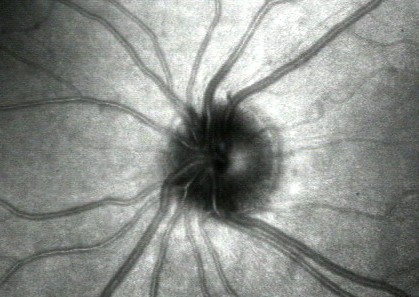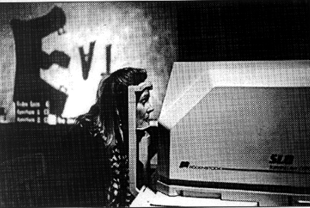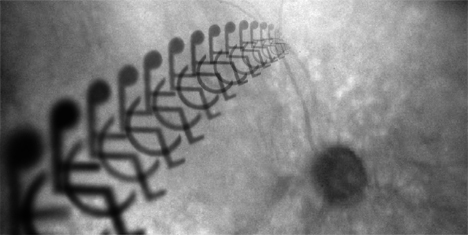Introduction
to the Many Projects of the Visual Experiences for the Blind Group
 Elizabeth Goldring’s creation of visual experiences for the visually impaired began when she was introduced to the scanning laser ophthalmoscope (SLO), a diagnostic tool used to examine the eye in search of functioning retina. As she looked through the SLO, the doctors were able to clearly view her retina, while Goldring was able to see simple pictures and words although she had only light and shadow perception. Elizabeth Goldring’s creation of visual experiences for the visually impaired began when she was introduced to the scanning laser ophthalmoscope (SLO), a diagnostic tool used to examine the eye in search of functioning retina. As she looked through the SLO, the doctors were able to clearly view her retina, while Goldring was able to see simple pictures and words although she had only light and shadow perception.
How the SLO Works
More on Elizabeth’s experience with the SLO
Goldring saw the possibility for many non-medical uses of the technology behind the SLO, and has executed several projects based on of this technology that would allow visually impaired participants to have meaningful visual experiences.
 The blindness that left Goldring, a poet, unable to read gave her a profound appreciation for the visual importance of language. One of the first projects she developed aimed to create a vocabulary of word-images that facilitated reading and comprehension. These word-images replaced hard-to-read letter combinations like the double ‘o’ in door with symbols and graphics that help to convey a word’s meaning. The blindness that left Goldring, a poet, unable to read gave her a profound appreciation for the visual importance of language. One of the first projects she developed aimed to create a vocabulary of word-images that facilitated reading and comprehension. These word-images replaced hard-to-read letter combinations like the double ‘o’ in door with symbols and graphics that help to convey a word’s meaning.
back to top
Visual Language for the Blind Samples
More about the Visual Language for the Blind Project
As Goldring looked at images through the SLO, she began to create a new form of art that attempts to convey blind/ sight or how she sees images through the machine. The Retina Prints portray layers of seeing and feature a retina looking at an image as well as how the image might appear to a blind or visually challenged viewer.
Retina Print Samples
More on the creation of Retina Prints and their meaning
One particularly useful project that Goldring and her associates are working on is the collection of architectural models that address visually challenged viewers. These virtual architectural models will allow visually impaired persons to pre-visit buildings/ sites. The chance to pre-visit locations before actually going there will alleviate some of the anxiety associated with visiting new places. One of the models is a walk-through of an art gallery featuring Goldring’s Retina Prints. This particular walkthrough allows users to see visual artwork normally off-limits to those who are visually challenged.
View An Architectural Walk-through
More on the use and development of architectural models
In an effort to make these art forms and technologies more accessible, Goldring collaborated with scientists and engineers at MIT, physicians at Harvard and the inventor of the SLO to realize some of the project’s potentials. One major step forward came with the development of the seeing machine prototype, a pilot study grant from NASA made it possible to test the seeing machine with a small group of potential users with varying causes and degrees of blindness. Participants in the study felt that the seeing machine as well as the architectural models and the visual language would be helpful to them.
back to top
More on the Black & White Seeing Machine and Its Pilot Study
Since the first seeing machine’s pilot study, the Vision Group has developed a color seeing machine that is currently being used to display works of art and an architectural model of an art gallery.
More on the Color Seeing Machine
Future perspectives/dreams include 1) An accessible, state of the art studio at MIT where visually challenged artists can collaborate with fully-sighted as well as sight impaired, scientists, engineers, architects, designers to produce trans disciplinary projects; 2) An internet based library of visual language and architectural models fully accessible to people who are visually challenged through a variety of computer-interfaced seeing devices; 3) Wide production and distribution of affordable, portable seeing machines based on the prototyped invented by Goldring’s group at the Center for Advanced Visual Studies.
back to top
More on the Seeing Machine Camera
The Seeing Machine Camera is a device that potentially enhances the ability of the visually challenged to see the face of a loved one, to view a landscape out a window, or to look at a painting in an art museum. For people who may now be isolated from the visual world, it provides useful and enjoyable vision enhancement which could lead to significant quality of life enhancement. Through several iterations, we have developed an inexpensive battery-powered portable device. We are currently undergoing clinical trials and are aiming to market the device as soon as possible.
|


 The blindness that left Goldring, a poet, unable to read gave her a profound appreciation for the visual importance of language. One of the first projects she developed aimed to create a vocabulary of word-images that facilitated reading and comprehension. These word-images replaced hard-to-read letter combinations like the double ‘o’ in door with symbols and graphics that help to convey a word’s meaning.
The blindness that left Goldring, a poet, unable to read gave her a profound appreciation for the visual importance of language. One of the first projects she developed aimed to create a vocabulary of word-images that facilitated reading and comprehension. These word-images replaced hard-to-read letter combinations like the double ‘o’ in door with symbols and graphics that help to convey a word’s meaning.